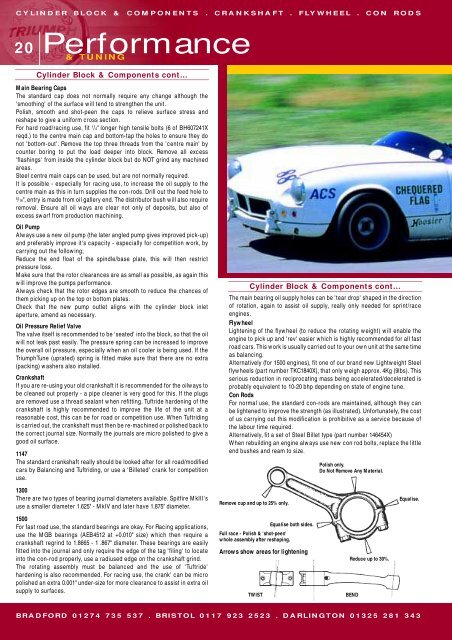You also want an ePaper? Increase the reach of your titles
YUMPU automatically turns print PDFs into web optimized ePapers that Google loves.
CYLINDER BLOCK & COMPONENTS . CRANKSHAFT . FLYWHEEL . CON RODS<br />
20<br />
Performance<br />
& TUNING<br />
Cylinder Block & Components cont...<br />
Main Bearing Caps<br />
The standard cap does not normally require any change although the<br />
'smoothing' of the surface will tend to strengthen the unit.<br />
Polish, smooth and shot-peen the caps to relieve surface stress and<br />
reshape to give a uniform cross section.<br />
For hard road/racing use, fit 1 /4" longer high tensile bolts (6 of BH607241X<br />
reqd.) to the centre main cap and bottom-tap the holes to ensure they do<br />
not 'bottom-out'. Remove the top three threads from the 'centre main' by<br />
counter boring to put the load deeper into block. Remove all excess<br />
'flashings' from inside the cylinder block but do NOT grind any machined<br />
areas.<br />
Steel centre main caps can be used, but are not normally required.<br />
It is possible - especially for racing use, to increase the oil supply to the<br />
centre main as this in turn supplies the con-rods. Drill out the feed hole to<br />
5 /16", entry is made from oil gallery end. The distributor bush will also require<br />
removal. Ensure all oil ways are clear not only of deposits, but also of<br />
excess swarf from production machining.<br />
Oil Pump<br />
Always use a new oil pump (the later angled pump gives improved pick-up)<br />
and preferably improve it's capacity - especially for competition work, by<br />
carrying out the following;<br />
Reduce the end float of the spindle/base plate, this will then restrict<br />
pressure loss.<br />
Make sure that the rotor clearances are as small as possible, as again this<br />
will improve the pumps performance.<br />
Always check that the rotor edges are smooth to reduce the chances of<br />
them picking up on the top or bottom plates.<br />
Check that the new pump outlet aligns with the cylinder block inlet<br />
aperture, amend as necessary.<br />
Oil Pressure Relief Valve<br />
The valve itself is recommended to be 'seated' into the block, so that the oil<br />
will not leak past easily. The pressure spring can be increased to improve<br />
the overall oil pressure, especially when an oil cooler is being used. If the<br />
TriumphTune (uprated) spring is fitted make sure that there are no extra<br />
(packing) washers also installed.<br />
Crankshaft<br />
If you are re-using your old crankshaft it is recommended for the oilways to<br />
be cleaned out properly - a pipe cleaner is very good for this. If the plugs<br />
are removed use a thread sealant when refitting. Tuftride hardening of the<br />
crankshaft is highly recommended to improve the life of the unit at a<br />
reasonable cost, this can be for road or competition use. When Tuftriding<br />
is carried out, the crankshaft must then be re-machined or polished back to<br />
the correct journal size. Normally the journals are micro polished to give a<br />
good oil surface.<br />
1147<br />
The standard crankshaft really should be looked after for all road/modified<br />
cars by Balancing and Tuftriding, or use a 'Billeted' crank for competition<br />
use.<br />
1300<br />
There are two types of bearing journal diameters available. Spitfire MkIII's<br />
use a smaller diameter 1.625" - <strong>MkIV</strong> and later have 1.875" diameter.<br />
<strong>1500</strong><br />
For fast road use, the standard bearings are okay. For Racing applications,<br />
use the MGB bearings (AEB4512 at +0.010" size) which then require a<br />
crankshaft regrind to 1.8665 - 1 .867" diameter. These bearings are easily<br />
fitted into the journal and only require the edge of the tag 'filing' to locate<br />
into the con-rod properly, use a radiused edge on the crankshaft grind.<br />
The rotating assembly must be balanced and the use of 'Tuftride'<br />
hardening is also recommended. For racing use, the crank' can be micro<br />
polished an extra 0.001" under-size for more clearance to assist in extra oil<br />
supply to surfaces.<br />
Cylinder Block & Components cont...<br />
The main bearing oil supply holes can be 'tear drop' shaped in the direction<br />
of rotation, again to assist oil supply, really only needed for sprint/race<br />
engines.<br />
Flywheel<br />
Lightening of the flywheel (to reduce the rotating weight) will enable the<br />
engine to pick up and 'rev' easier which is highly recommended for all fast<br />
road cars. This work is usually carried out to your own unit at the same time<br />
as balancing.<br />
Alternatively (for <strong>1500</strong> engines), fit one of our brand new Lightweight Steel<br />
flywheels (part number TKC1840X), that only weigh approx. 4Kg (9lbs). This<br />
serious reduction in reciprocating mass being accelerated/decelerated is<br />
probably equivalent to 10-20 bhp depending on state of engine tune.<br />
Con Rods<br />
For normal use, the standard con-rods are maintained, although they can<br />
be lightened to improve the strength (as illustrated). Unfortunately, the cost<br />
of us carrying out this modification is prohibitive as a service because of<br />
the labour time required.<br />
Alternatively, fit a set of Steel Billet type (part number 146454X)<br />
When rebuilding an engine always use new con rod bolts, replace the little<br />
end bushes and ream to size.<br />
Remove cup and up to 25% only.<br />
Full race - Polish & 'shot-peen'<br />
whole assembly after reshaping.<br />
Equalise both sides.<br />
Arrows show areas for lightening<br />
Polish only.<br />
Do Not Remove Any Material.<br />
TWIST BEND<br />
Reduce up to 30%.<br />
BRADFORD 01274 735 537 . BRISTOL 0117 923 2523 . DARLINGTON 01325 281 343<br />
Equalise.


